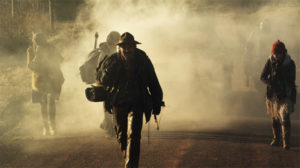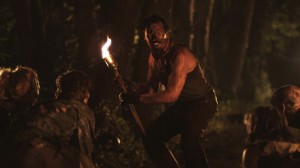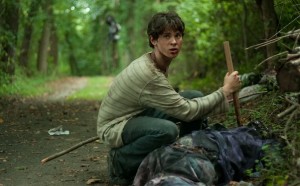Over the past couple years we’ve been treated with a trio of remarkably good and original vampire films. 2008’s Let the Right One In and its American remake, 2010’s Let Me In, were beautiful explorations of what it is to be an outsider. The third film is this year’s Stake Land. Set in a post-apocalyptic America Stake Land tells the story of Martin (Gossip Girl’s Connor Paolo) who, following the murder of his parents, sets out with Mister (Nick Damici), a ruthless vampire hunter, to travel north towards the safety of Canada’s New Eden.
Much like the recent film adaptation of Cormac McCarthy’s novel The Road, Stake Land’s landscape is desolate and dangerous and its themes focus on the human spirit and the need to not only to survive but to also hold on to a greater sense of being. It is a brilliant character drama garnished with violence and fantasy and the best horror themed film of 2011.
Stake Land’s journey from script to screen is as interesting as the movie itself. To celebrate the film’s Blu-ray and DVD release I was given the opportunity to speak with director/co-writer Jim Mickle and co-writer/actor Nick Damici. Together the duo explains the strange journey of how Stake Land came to be.
Following the initial reviews of his debut feature film, the zombie-infection movie Mulberry Street, Mickle says that he “got a taste of what happens when people rally against your movie.” Of course, as most horror fans know all too well, mainstream critics and non-genre fans tend to dismiss films involving monsters purely on principle (unless it came from Universal Studios before 1960 or has Steven Spielberg’s name attached to it). When Mulberry Street, which was part of After Dark Films 8 Films to Die For 2007, made its way to its intended audience the reaction was significantly better.
For his next project Mickle re-teamed with Damici, who had been Mulberry Street’s co-writer and lead actor. Because there was no outside funding the duo decided to create a series of webisodes. Damici was able to hammer out a storyline that was set in the modern world where the government issues contracts to various mercenary types to hunt down the growing vampire population. Damici, a self-professed a fan of vampire fiction, wanted each webisode to feature a different kind of vampires. These types would range from the stereotypical sophisticated vampire to the brain-dead mongrel variety. Damici explains that vampires were a result of a disease or a virus, rather than traditional vampire lore, and that the different types of would be a result of the virus causing different mutations in those that were infected.
An early draft of the script made its way into the hands of actor/writer/producer Larry Fessenden (I Sell the Dead, Bitter Feast) who thought it would make a wonderful film. So Fessenden’s Glass Eye Pix as well as Belladonna Productions (who had produced Mulberry Street) came on board with the funding to produce a feature film.
Together Mickle and Damici sorted through what had been written and looked to make a more cohesive storyline. Both Mickle and Damici insist that the majority of Stake Land’s plot was in the original script. Damici, who does most of the writing, says the John Wayne film The Searchers originally inspired the story and that much of that plot element remained intact. Mickle wanted to keep the episodic element and suggested that the film be broken up into distinct chapters. The chapter concept was subsequently abandoned and the story’s setting was shifted to a post-apocalyptic and the government’s role as a contract agency was dropped entirely.
A test trailer was made using a Red One Camera and the results gave Mickle the confidence that he would be able to make the film he wanted without exceeding their modest budget.
As pre-production moved forward the fine tuning of the script continued. The casting of Danielle Harris as Belle forced Damici to rewrite various aspects of the story. Initially Belle was a “bar broad” romantically connected with Damici’s Mister character, but Harris’ youthful appearance necessitated the change.
Principle photography was shot in two two-week shoots that were separated by a couple months of downtime. During the break between shoots the producers asked that the film’s second half be reworked.
Damici explains that in his first draft the film “moved into Jack London territory.” The vampires and The Brotherhood, a religious group that believes the vampire mutations to be the work of God, dropped out of the storyline almost completely as Mister and Martin pushed towards Canada. There would have been more about the rumors of cannibalism that are mentioned early in the film and that there would have been an island reminiscent of the tribal society in Apocalypse Now. Damici admits he doesn’t know if the changes made the film better or worse.
Mickle says he could “clearly see both sides” of the argument. He liked Damici’s original ideas but understood why the producers thought it best to keep the vampire element throughout the film. He also suggests that it “leaves stuff out there” should they want to use the ideas later.
Even with the script in place Damici says it was used as a blueprint but there were still changes made throughout the filming process. The fate of Belle was a last minute addition, as was some of Peggy’s (Bonnie Dennison) dialogue at the end of the film. If something didn’t work or felt incomplete he’d simply sit down and write something new.
When asked about a possible sequel Damici says they’ve discussed having the story pick up ten years after the events of Stake Land and that he’s insisting on flying vampires based on the winged monkeys from The Wizard of Oz.
The DVD and Blu-ray release of Stake Land feature the film’s trailer and two extremely informative and entertaining commentaries. One features Mickle with Damici, Connor Paolo, Larry Fessenden and producer Brent Kunkle. The other has Mickle teamed with producers Peter Phok and Adam Folk, cinematographer Ryan Samul, composer Jeff Grace and sound designer Graham Reznick. The second, or crew, commentary is particularly insightful as it shows the amount of trust it takes to make a film, particularly when the budget is tight.
The Blu-ray has numerous exclusive features including video diaries covering pre-production through to post-production (including an excellent look at the film’s judicious use of CGI), a making-of featurette, the Q&A from the Toronto International Film Festival Premiere and seven short film prequels directed by Larry Fessenden, Danielle Harris, Glenn McQuaid, JT Petty and Graham Reznick. Some of the information overlaps with what is said in the commentaries but only the Q&A feels like filler (and that’s mostly due to the audience’s uninspired questions).
If you like intelligent genre films and haven’t seen Stake Land you absolutely owe it to yourself to check it out. I highly recommend the Blu-ray release. It has a strong video and audio presentation and a great selection of bonus features. In comparison the DVD release is a bit underwhelming but that’s to be expected.


